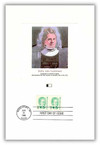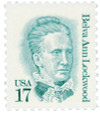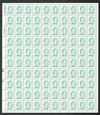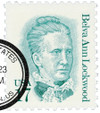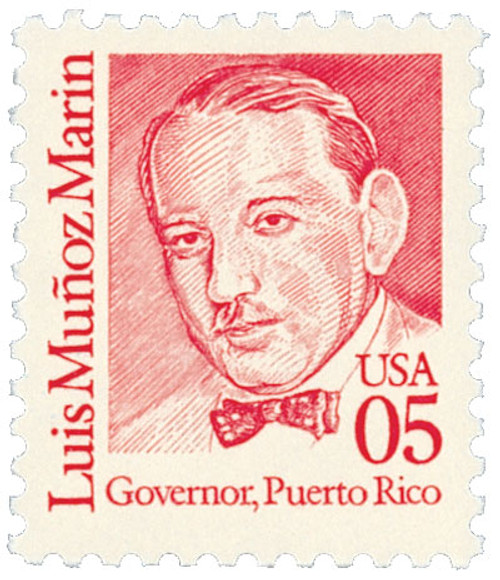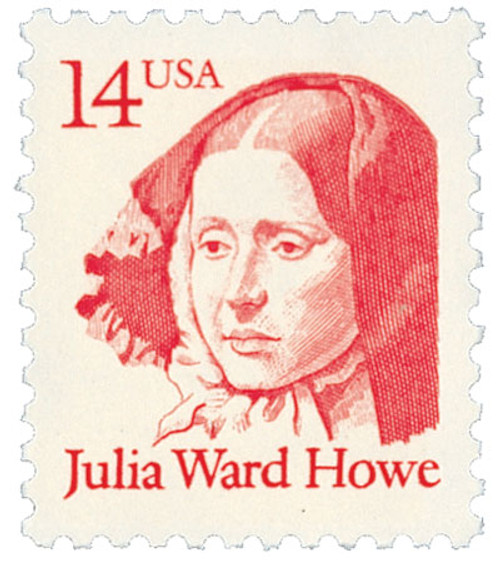
# 2178 - 1986 17c Great Americans: Belva Ann Lockwood
U.S. #2178
1986 17¢ Belva Ann Lockwood
Great Americans
- 30th stamp in Great Americans Series
- Honors the first woman to argue a case before the US Supreme Court
Stamp Category: Definitive
Series: Great Americans
Value: 17¢, second-ounce-and-over rate for first-class mail
First Day of Issue: June 18, 1986
First Day City: Middleport, New York
Quantity Issued: 156,520,000
Printed by: Bureau of Engraving and Printing
Printing Method: Engraved
Format: Panes of 100 in sheets of 800
Perforations: 11.1
Color: Deep blue green
Why the stamp was issued: This stamp replaced the 1981 17¢ Rachel Carson stamp, paying the additional postage for first-class mail of two ounces or more.
About the stamp design: This was Christopher Calle’s fifth stamp design. While his original design was largely accepted, he was asked to make Lockwood’s bun more pronounced and add in additional background shading.
First Day City: The First Day ceremony for this stamp was held at the Royalton-Hartland Junior-Senior High School in Middleport, New York
About the Great Americans Series: The Great Americans Series was created to replace the Americana Series. The new series would be characterized by a standard definitive size, simple design, and monochromatic colors.
This simple design included a portrait, “USA,” the denomination, the person’s name, and in some cases, their occupation or reason for recognition. The first stamp in the new series was issued on December 27, 1980. It honored Sequoyah and fulfilled the new international postcard rate that would go into effect in January 1981.
The Great Americans Series would honor a wider range of people than the previous Prominent Americans and Liberty Series. While those series mainly honored presidents and politicians, the Great Americans Series featured people from many fields and ethnicities. They were individuals who were leaders in education, the military, literature, the arts, and human and civil rights. Plus, while the previous series only honored a few women, the Great Americans featured 15 women. This was also the first definitive series to honor Native Americans, with five stamps.
The Bureau of Engraving and Printing (BEP) produced most of the stamps, but private firms printed some. Several stamps saw multiple printings. The result was many different varieties, with tagging being the key to understanding them. Though there were also differences in perforations, gum, paper, and ink color.
The final stamp in the series was issued on July 17, 1999, honoring Justin S. Morrill. Spanning 20 years, the Great Americans was the longest-running US definitive series. It was also the largest series of face-different stamps, with a total of 63.
Click here for all the individual stamps and click here for the complete series.
History the stamp represents: On November 30, 1880, Belva Ann Lockwood became the first woman to argue a case before the US Supreme Court. She was the first female member of the US Supreme Court Bar and paved the way for future female lawyers.
Belva Ann Bennett Lockwood was born on October 24, 1830, in Royalton, New York. She began teaching when she was 14 and got married when she was 18. Her first husband died three years after the birth of their daughter. For several years, Belva taught and worked as principal or headmistress of several schools. She was usually paid half what her male colleagues earned.
Belva then met Susan B. Anthony, who shared many of her concerns about women’s education. At the time, most women’s courses focused on domestic duties or teaching. Belva and Anthony believed women should be trained for jobs in business. Belva began changing the curriculum at the schools she worked at, offering young women courses in public speaking, botany, and gymnastics. Belva soon decided she wanted to further her own education to provide more opportunities for herself and her daughter.
Belva attended Genesee Wesleyan Seminary and Genesee College where she first became interested in studying law. She was refused admission to Columbia Law School, but was admitted with several other women to the National University School of Law (now the George Washington University Law School). Belva completed her coursework in 1872, but the school refused to give her a diploma because she was a woman. She eventually wrote a letter to President Ulysses S. Grant calling for justice. Within a week, she received her diploma, at age 43.
Belva was admitted to the District of Columbia Bar, but several judges criticized her. When she attempted to join the Maryland Bar, a judge told her that women were not equal to men and when she tried to respond, he ordered her removed from the courtroom. Belva applied to the Court of Claims to represent veterans and their families, but was rejected. Belva opened her own practice and won some of her cases, convincing some skeptics of her abilities.
Belva worked for the three years required to apply to the US Supreme Court Bar. They rejected her application, saying they would only admit women if Congress passed a federal law. Belva repeatedly lobbied Congress until a “bill to relieve certain legal disabilities of women” was passed in February 1879. On March 3, 1879, she became the first female member of the Supreme Court Bar.
The following year, Belva became the first woman to argue a case before the US Supreme Court on November 30, 1880. In the case of Kaiser v. Stickney, she represented property owner Caroline Kaiser in a debt dispute. She lost that case, but came before the Supreme Court again in 1906 in the case of United States v. Cherokee Nation. Representing the Cherokee Nation, she successfully argued that the government owed the Cherokee $5 million.
In 1884 and 1888, Lockwood ran for president of the United States. She was the National Equal Rights Party candidate and the first woman to appear on official ballots. (Victoria Woodhall ran in 1872, but she wasn’t yet 35, the constitutionally mandated age to run.) Belva received about 4,000 votes in a time when women could not vote and most newspapers were against her campaign.
Belva retired after working as a lawyer for 43 years. She remained active in the women’s rights movement and the Universal Peace Union. She died on May 19, 1917. Towns and counties in California, Virginia, and New York were named in her honor, as well as a World War II merchant marine ship. She was inducted into the National Women’s Hall of Fame in 1983.
U.S. #2178
1986 17¢ Belva Ann Lockwood
Great Americans
- 30th stamp in Great Americans Series
- Honors the first woman to argue a case before the US Supreme Court
Stamp Category: Definitive
Series: Great Americans
Value: 17¢, second-ounce-and-over rate for first-class mail
First Day of Issue: June 18, 1986
First Day City: Middleport, New York
Quantity Issued: 156,520,000
Printed by: Bureau of Engraving and Printing
Printing Method: Engraved
Format: Panes of 100 in sheets of 800
Perforations: 11.1
Color: Deep blue green
Why the stamp was issued: This stamp replaced the 1981 17¢ Rachel Carson stamp, paying the additional postage for first-class mail of two ounces or more.
About the stamp design: This was Christopher Calle’s fifth stamp design. While his original design was largely accepted, he was asked to make Lockwood’s bun more pronounced and add in additional background shading.
First Day City: The First Day ceremony for this stamp was held at the Royalton-Hartland Junior-Senior High School in Middleport, New York
About the Great Americans Series: The Great Americans Series was created to replace the Americana Series. The new series would be characterized by a standard definitive size, simple design, and monochromatic colors.
This simple design included a portrait, “USA,” the denomination, the person’s name, and in some cases, their occupation or reason for recognition. The first stamp in the new series was issued on December 27, 1980. It honored Sequoyah and fulfilled the new international postcard rate that would go into effect in January 1981.
The Great Americans Series would honor a wider range of people than the previous Prominent Americans and Liberty Series. While those series mainly honored presidents and politicians, the Great Americans Series featured people from many fields and ethnicities. They were individuals who were leaders in education, the military, literature, the arts, and human and civil rights. Plus, while the previous series only honored a few women, the Great Americans featured 15 women. This was also the first definitive series to honor Native Americans, with five stamps.
The Bureau of Engraving and Printing (BEP) produced most of the stamps, but private firms printed some. Several stamps saw multiple printings. The result was many different varieties, with tagging being the key to understanding them. Though there were also differences in perforations, gum, paper, and ink color.
The final stamp in the series was issued on July 17, 1999, honoring Justin S. Morrill. Spanning 20 years, the Great Americans was the longest-running US definitive series. It was also the largest series of face-different stamps, with a total of 63.
Click here for all the individual stamps and click here for the complete series.
History the stamp represents: On November 30, 1880, Belva Ann Lockwood became the first woman to argue a case before the US Supreme Court. She was the first female member of the US Supreme Court Bar and paved the way for future female lawyers.
Belva Ann Bennett Lockwood was born on October 24, 1830, in Royalton, New York. She began teaching when she was 14 and got married when she was 18. Her first husband died three years after the birth of their daughter. For several years, Belva taught and worked as principal or headmistress of several schools. She was usually paid half what her male colleagues earned.
Belva then met Susan B. Anthony, who shared many of her concerns about women’s education. At the time, most women’s courses focused on domestic duties or teaching. Belva and Anthony believed women should be trained for jobs in business. Belva began changing the curriculum at the schools she worked at, offering young women courses in public speaking, botany, and gymnastics. Belva soon decided she wanted to further her own education to provide more opportunities for herself and her daughter.
Belva attended Genesee Wesleyan Seminary and Genesee College where she first became interested in studying law. She was refused admission to Columbia Law School, but was admitted with several other women to the National University School of Law (now the George Washington University Law School). Belva completed her coursework in 1872, but the school refused to give her a diploma because she was a woman. She eventually wrote a letter to President Ulysses S. Grant calling for justice. Within a week, she received her diploma, at age 43.
Belva was admitted to the District of Columbia Bar, but several judges criticized her. When she attempted to join the Maryland Bar, a judge told her that women were not equal to men and when she tried to respond, he ordered her removed from the courtroom. Belva applied to the Court of Claims to represent veterans and their families, but was rejected. Belva opened her own practice and won some of her cases, convincing some skeptics of her abilities.
Belva worked for the three years required to apply to the US Supreme Court Bar. They rejected her application, saying they would only admit women if Congress passed a federal law. Belva repeatedly lobbied Congress until a “bill to relieve certain legal disabilities of women” was passed in February 1879. On March 3, 1879, she became the first female member of the Supreme Court Bar.
The following year, Belva became the first woman to argue a case before the US Supreme Court on November 30, 1880. In the case of Kaiser v. Stickney, she represented property owner Caroline Kaiser in a debt dispute. She lost that case, but came before the Supreme Court again in 1906 in the case of United States v. Cherokee Nation. Representing the Cherokee Nation, she successfully argued that the government owed the Cherokee $5 million.
In 1884 and 1888, Lockwood ran for president of the United States. She was the National Equal Rights Party candidate and the first woman to appear on official ballots. (Victoria Woodhall ran in 1872, but she wasn’t yet 35, the constitutionally mandated age to run.) Belva received about 4,000 votes in a time when women could not vote and most newspapers were against her campaign.
Belva retired after working as a lawyer for 43 years. She remained active in the women’s rights movement and the Universal Peace Union. She died on May 19, 1917. Towns and counties in California, Virginia, and New York were named in her honor, as well as a World War II merchant marine ship. She was inducted into the National Women’s Hall of Fame in 1983.







